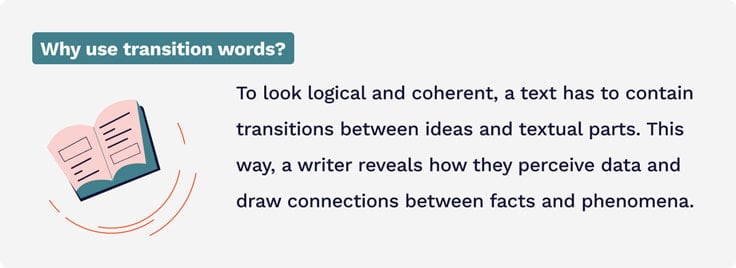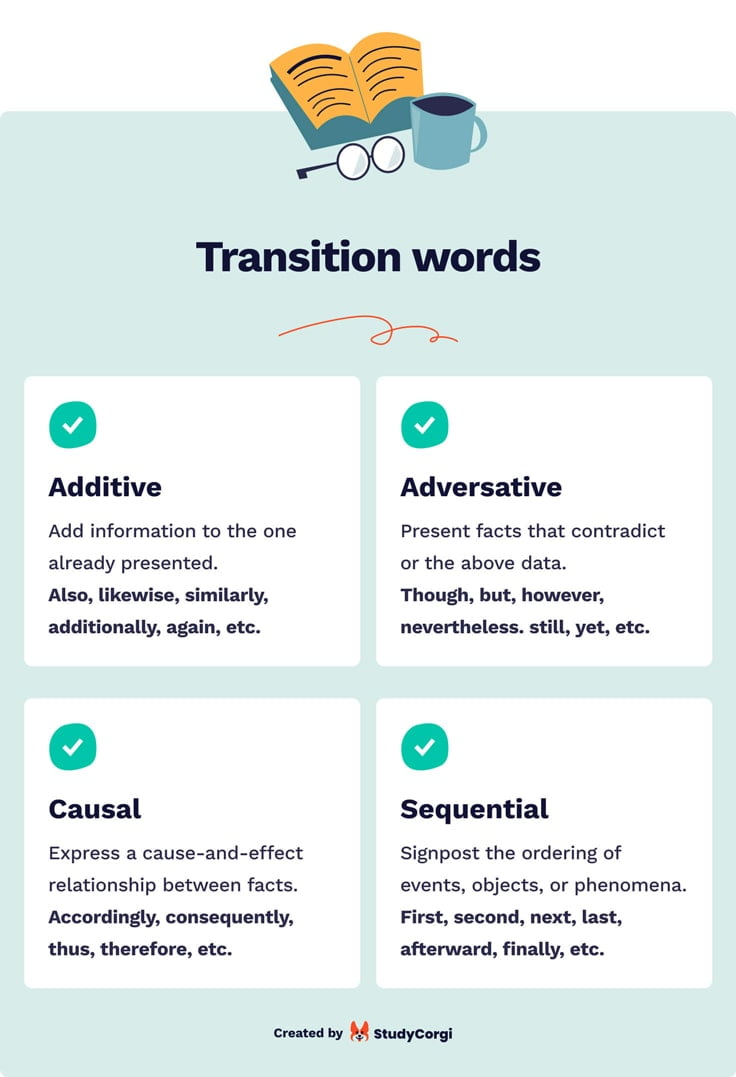📝 Transition Words Generator – How to Use It?
Transitions play a vital role in any text by adding cohesion and logical flow to it.
Do you need assistance with this important writing stage? Then there’s no better solution than our transition words maker – an automatic tool that fits any writing genre and style and can speed up your writing process.
Take the following steps to use the tool:
- Choose what you need the instrument to do: add transition words to your text or provide you with suitable transition word examples.
- Add the necessary information: paste your text or choose what kinds of transition word ideas you need to get.
- Press the button and enjoy the result.
👌 The Benefits of This Transition Words Maker
Why choose our transition words generator that will improve your flow and add liveliness to your content?
Here are several key benefits of this instrument:
| 🎯 Customizable | You can determine the type and purpose of transition words to get individually tailored results. |
|---|---|
| 💸 Free | This transitional word generator is totally free to use, without any conditions, trial runs, and freemiums. |
| 🔀 Flexible | You can either get a list of transition words or add them directly to the body of your ready text. |
| 🤝 User-friendly | The interface is highly intuitive, with many user prompts guiding you throughout the transition word generation process. |
🎓 Transitional Words in Academic Writing
For your text to look logical and coherent, it has to connect ideas and textual parts.
Why so?
This way, a writer reveals how they perceive data and draw connections between facts and phenomena.

This is best achieved with the help of transitions that assist readers to make sense of:
- Whether the writer juxtaposes or compares objects
- Whether they see any contradictions in various sources
- Whether they talk about the same idea or voice a new one
Therefore:
Transitions in any academic writing work like signposts for readers, showing the links between separate chunks of information and the relationships an author sees between them.
With these cues, the readers can follow the data flow and come to the same conclusion an author has made.
🤔 Do I Need to Add Transitional Words?
So, when should you think of adding transitional words to your essay?
Here are some examples of evidence your paper lacks these essential coherence tools:
- Your professor has evaluated the paper as “chunky” or “abrupt,” pointing out a lack of connections between text parts.
- Your readers complain of the difficulty following your ideas and going from one paragraph to another one.
- You’ve composed an assignment in several body parts first and then compiled it all into a single whole.
- You add content to a group project, which means that it needs to link somehow to the existing text.
✍️ Transition Words: Types & Examples
Here are the best transition words you may utilize to make your text more readable and cohesive.

These 4 categories are all present in our tool, enabling you to generate transitions specifically meant for each purpose.
Additive Transition Words
Additive transitions are used to add information to the one already presented, showing that these new pieces of data follow the previous ones and align with them in meaning.
Some examples of additive transitions are:
- Also
- Likewise
- Similarly
- Moreover
- Additionally
- Again
- Besides
Here’s an illustration of their use in context:
EXAMPLE #1
Diabetes is getting more widespread in all countries of the world. Besides, the disease is getting younger, with preschoolers and schoolers affected at higher rates than several decades ago.EXAMPLE #2
James (2009) clarified that mental health disorders have been escaping the gaze of medical community because of the absence of physical symptoms for many centuries. Similarly, lifestyle issues are currently not considered a medical problem, though they cause the development of chronic diseases in the long run.Adversative Transition Words
Adversative transitions are meant to juxtapose information in the text and give facts that contradict or don’t support the data presented before.
Here are a couple of examples of such transitions:
- Though/although
- But
- However
- Nevertheless
- Still
- Yet
- Notwithstanding
Let’s illustrate their use in two examples:
EXAMPLE #1
The habit of drinking freshly squeezed juices has for a long time been regarded as healthy. However, research recently proved that daily fresh juice consumption can cause diabetes.EXAMPLE #2
Traveling is a positive lifestyle habit, but it requires spare money, physical resilience, and mental balance to be open to new adventures and experiences.Causal Transition Words
Causal transitions are meant to express a cause-and-effect relationship between events and phenomena.
Some of them are as follows:
- Accordingly
- Consequently
- Thus
- Therefore
Here is an illustration of their use in context:
EXAMPLE #1
Children don’t have the willpower to stop and control themselves in their early years. Therefore, it’s impossible to talk them into changing their conduct or appeal to their conscience. The parent’s responsibility is to shift the child’s attention and soothe their nervous system.EXAMPLE #2
Jane was always late for work. Consequently, she could never stay in one job for over three months. Her bosses couldn’t tolerate such a light-hearted attitude to her work schedule.Sequential Transition Words
Sequential transitions are used to signpost the ordering of events, objects, or phenomena in a list. Though ordering may seem simple within one sentence, extended lists with explanations of each point may distract readers from the gist.
This is when sequential transitions come in handy:
- First
- Second
- Next
- Last
- Afterward
- Finally
Here are a couple of examples to illustrate their use in context:
EXAMPLE #1
First, there was a ban on political opposition. Next came new laws restricting public speech. Finally, the state deteriorated into fully authoritarian control.EXAMPLE #2
A healthy lifestyle is impossible without starting to listen to your body’s needs. First, you should identify your health problem or at least the symptoms that bother you. Next, it’s vital to check your medical insurance to explore your opportunities. Afterward, you can schedule a doctor’s appointment and start the treatment.Thank you for reading this article! If you want to get transition phrases and sentences, check the tools we’ve developed:
❓ Transitional Words Maker FAQ
❓ What are some great transition words?
There are dozens of good transition words, each suited to a specific context and purpose. For instance, “also” and “likewise” are great for talking about similarities, and words like “afterward” or “recently” work well to determine the timing of events.
❓ What are cause and effect transition words?
You can use transitions like “accordingly,” “consequently,” or “therefore” to identify a cause-and-effect relationship between events or variables. More precisely, you will denote the transition from the discussion of causes to the evidence of effects with these words.
❓ Where to use transition words?
Transition words differ by function and have different places where their use will be appropriate. For instance, some transitions connect parts of a compound sentence, and others work better between paragraphs by ending one piece of your content and starting a new argument.
❓ What are good conclusion transition words?
It’s vital to give your readers pointers throughout the text to let them monitor the flow of your ideas and your transition from the body of your paper to concluding remarks. It makes sense to signpost the conclusions with transitions like “finally,” “thus,” or “overall.”